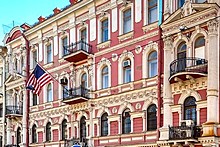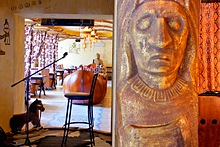American St. Petersburg
Like the United States, St. Petersburg was founded in the 18th century, and like the Unites States, St. Petersburg was built and populated by immigrants from all across Europe. And yet, while rooted in European culture and essentially European in character, both Russia and the United States retained an uneasy and ambiguous relationship with the Old World, by turns embracing their position in Western Civilization and rejecting its perceived decadence in favour of a more primitive, homegrown culture.

While politically they were, at least in theory, poles apart, diplomatically the young United States and the Imperial Court in St. Petersburg retained almost unbroken excellent relations. Russia was the first major power to recognize the new country after the Declaration of Independence in 1776 (the favour would be returned in 1917, when the USA was the first country to recognize the legitimacy of the Provisional Government in St. Petersburg), and among the US Ministers to Russia, ambassadors to St. Petersburg during the 19th century, were two future presidents, John Quincy Adams and James Buchanan, and many other prominent statesmen.
After the October Revolution, many important Petersburg emigres eventually made their way to the United States, among the most famous being Sergei Rachmaninoff, Igor Stravinsky and Vladimir Nabokov. Half a century later, they were followed by a fresh wave of talented dissidents and defectors, including the Petersburg writers Joseph Brodsky and Sergey Dovlatov.
A new life in the USA remained a dream for many Russians right through the 1990s, and one that became a reality for thousands of artists, scientists, engineers and computer programmers from St. Petersburg. At the same time, the influence of American youth culture, repressed for so long by the Soviet authorities, was at its height. The arrival of burgers, Levis jeans, Coca-Cola and MTV were for the majority the most tangible aspects of the new-found freedoms that the collapse of the Soviet Union introduced. A local, specifically Petersburgian, expression of this love for all things American was the explosion in popularity of traditional rock 'n roll and rockabilly, which dominated the city's live music scene in the mid to late nineties.
While enthusiasm for the American way of life may have cooled over the last decade, just as a certain level of political antagonism has returned to relationships between the two countries, cultural ties remain vital to many of St. Petersburg's greatest institutions - the Hermitage with the Guggenheim Museum and the Mariinsky Theatre with the Metropolitan Opera House. The cultural wealth shared by St. Petersburg and the USA and the large number of American citizens with recent roots in the city mean that private relations between Petersburgers and Americans are stronger than ever.





